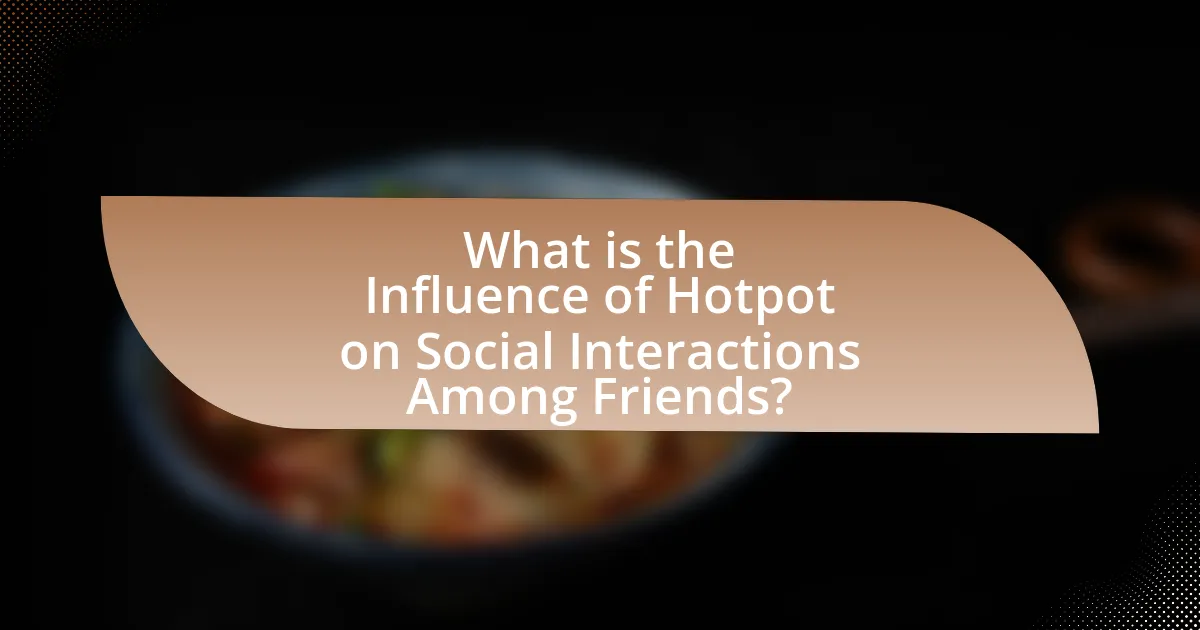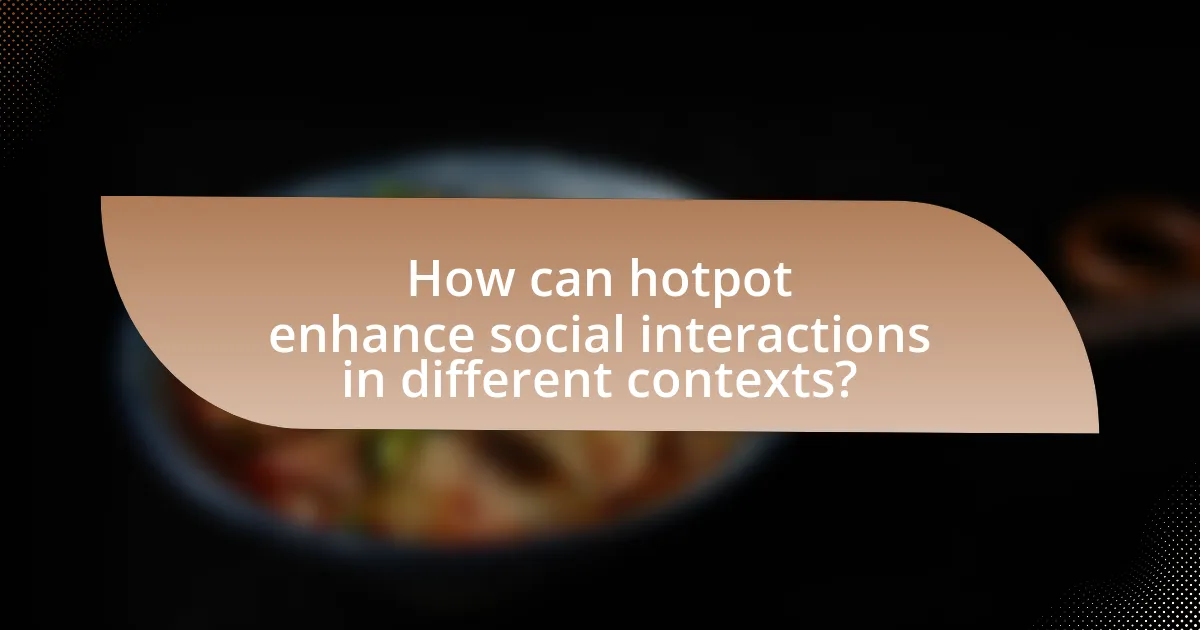The article examines the influence of hotpot on social interactions among friends, highlighting its role in fostering communal dining experiences that enhance conversation and bonding. It discusses how the interactive nature of hotpot encourages engagement, collaboration, and deeper connections, supported by research indicating that shared meals increase feelings of belonging and relationship satisfaction. Key elements such as communal cooking, diverse ingredient selection, and the relaxed atmosphere of hotpot dining are explored, along with the psychological effects of sharing meals, including trust and intimacy. The article also addresses the cultural significance of hotpot in social settings and offers practical tips for enhancing the hotpot dining experience to promote social interaction.

What is the Influence of Hotpot on Social Interactions Among Friends?
Hotpot significantly enhances social interactions among friends by fostering a communal dining experience that encourages conversation and bonding. The interactive nature of hotpot, where participants cook their own food at the table, promotes engagement and collaboration, leading to deeper connections. Research indicates that shared meals, such as hotpot, can increase feelings of belonging and strengthen friendships, as evidenced by a study published in the Journal of Social and Personal Relationships, which found that communal dining experiences lead to higher levels of satisfaction in social relationships.
How does the hotpot dining experience foster social connections?
The hotpot dining experience fosters social connections by encouraging communal cooking and sharing of food among participants. This interactive format promotes engagement, as diners gather around a shared pot, cooking ingredients together and enjoying the process of meal preparation. Research indicates that shared meals enhance social bonds, as they create opportunities for conversation and collaboration, reinforcing relationships. Additionally, the informal and relaxed atmosphere of hotpot dining allows for open dialogue, making it easier for friends to connect and strengthen their ties.
What elements of hotpot dining encourage group participation?
Hotpot dining encourages group participation through its communal cooking style, interactive experience, and shared food selection. The communal cooking allows diners to engage with each other while preparing their meals, fostering conversation and collaboration. The interactive experience of cooking ingredients in a shared pot creates a sense of togetherness, as participants can customize their meals and share in the cooking process. Additionally, the shared food selection promotes group decision-making, as diners choose ingredients together, enhancing social bonds and collective enjoyment. These elements collectively create an environment conducive to social interaction and participation among friends.
How does the communal nature of hotpot affect conversation dynamics?
The communal nature of hotpot fosters a more interactive and engaging conversation dynamic among participants. This shared dining experience encourages individuals to communicate more openly, as the act of cooking and sharing food creates a relaxed atmosphere conducive to dialogue. Research indicates that communal meals, such as hotpot, enhance social bonding and increase the frequency of conversations, as people are more likely to discuss their preferences, cooking techniques, and personal stories while enjoying the meal together. This interaction is further supported by the fact that the collaborative nature of preparing and sharing food promotes a sense of belonging and connection, which can lead to deeper conversations and stronger relationships among friends.
Why is hotpot a popular choice for social gatherings among friends?
Hotpot is a popular choice for social gatherings among friends because it fosters a communal dining experience that encourages interaction and collaboration. The act of cooking together at the table allows friends to engage in conversation while sharing a variety of ingredients, which enhances the social atmosphere. Additionally, hotpot meals are customizable, catering to diverse tastes and dietary preferences, making it inclusive for all participants. This shared experience is supported by cultural practices in many Asian societies, where communal eating is a traditional way to strengthen bonds among friends and family.
What cultural significance does hotpot hold in social settings?
Hotpot holds significant cultural importance in social settings as it fosters communal dining and strengthens interpersonal bonds. This cooking style encourages shared experiences, where participants gather around a simmering pot to cook and enjoy food together, promoting interaction and conversation. In many Asian cultures, such as Chinese and Mongolian, hotpot is traditionally associated with family gatherings and celebrations, symbolizing unity and togetherness. The act of sharing food from a communal pot reflects values of cooperation and harmony, reinforcing social ties among friends and family.
How does the variety of ingredients enhance the social experience?
The variety of ingredients enhances the social experience by fostering engagement and interaction among participants. When individuals gather around a hotpot, the diverse selection of ingredients encourages conversation as they discuss preferences, cooking methods, and flavor combinations. This interactive cooking process not only promotes collaboration but also creates a shared experience, strengthening social bonds. Research indicates that communal dining experiences, such as hotpot, can lead to increased feelings of connection and satisfaction among friends, as they actively participate in the meal preparation and enjoy the results together.

What are the psychological effects of sharing a hotpot meal?
Sharing a hotpot meal fosters social bonding and enhances feelings of connection among participants. This communal dining experience encourages interaction, promotes cooperation in food preparation, and creates a shared sense of enjoyment, which can lead to increased feelings of happiness and belonging. Research indicates that shared meals, such as hotpot, can strengthen interpersonal relationships and improve overall well-being by facilitating communication and reducing social anxiety. For instance, a study published in the Journal of Social and Personal Relationships found that shared meals significantly enhance relationship satisfaction and emotional closeness among friends.
How does sharing food impact feelings of closeness among friends?
Sharing food significantly enhances feelings of closeness among friends by fostering connection and intimacy. When friends share meals, they engage in a communal experience that promotes bonding through shared tastes, conversations, and memories. Research indicates that communal eating activates the brain’s reward system, releasing oxytocin, a hormone associated with social bonding. A study published in the journal “Appetite” found that individuals who share food report higher levels of trust and cooperation, which are essential components of friendship. This shared experience not only strengthens existing relationships but also creates a sense of belonging, making friends feel more connected to one another.
What role does food sharing play in building trust and intimacy?
Food sharing plays a crucial role in building trust and intimacy among individuals. When people share food, they engage in a communal experience that fosters connection and strengthens relationships. This act of sharing often involves vulnerability, as individuals open themselves up to others by offering a part of their sustenance, which can enhance feelings of safety and belonging. Research indicates that shared meals can lead to increased cooperation and bonding, as evidenced by studies showing that communal dining experiences promote prosocial behavior and emotional closeness. For instance, a study published in the journal “Appetite” found that sharing food can enhance feelings of trust and intimacy, as participants reported feeling more connected to those with whom they shared meals.
How do shared meals influence group identity and belonging?
Shared meals significantly enhance group identity and belonging by fostering social bonds and creating a sense of community. When individuals partake in shared meals, such as hotpot, they engage in a collective experience that promotes interaction, communication, and cooperation. This communal dining experience allows participants to share not only food but also stories, traditions, and cultural practices, reinforcing their shared identity. Research indicates that communal meals can lead to increased feelings of trust and belonging among participants, as evidenced by a study published in the journal “Social Influence,” which found that shared dining experiences positively correlate with group cohesion and identity formation.
What are the emotional benefits of enjoying hotpot with friends?
Enjoying hotpot with friends fosters emotional benefits such as enhanced bonding, increased feelings of belonging, and improved mood. The communal nature of hotpot encourages shared experiences, which strengthens relationships and creates lasting memories. Research indicates that shared meals, like hotpot, can elevate oxytocin levels, a hormone associated with social bonding and trust. Additionally, the interactive cooking process allows for laughter and conversation, contributing to a positive emotional atmosphere. This combination of social interaction and shared enjoyment leads to a greater sense of community and emotional well-being among friends.
How does the hotpot experience contribute to positive memories?
The hotpot experience contributes to positive memories by fostering social interaction and shared enjoyment among friends. This communal dining style encourages collaboration, as participants cook together and share food, which enhances bonding and creates a sense of belonging. Research indicates that shared meals, such as hotpot, can lead to increased feelings of happiness and satisfaction, as they promote communication and laughter. Additionally, the unique flavors and cooking process associated with hotpot create memorable sensory experiences that are often associated with positive emotions, reinforcing the likelihood of recalling these moments fondly in the future.
What are the effects of laughter and enjoyment during hotpot meals?
Laughter and enjoyment during hotpot meals enhance social bonding and improve overall dining experience. Engaging in laughter fosters a positive atmosphere, which can lead to increased feelings of connection among friends. Research indicates that shared laughter releases endorphins, promoting feelings of happiness and reducing stress, thereby making the meal more enjoyable. Additionally, the interactive nature of hotpot dining encourages communication and collaboration, further strengthening relationships. Studies have shown that meals characterized by laughter and enjoyment can lead to longer-lasting friendships and improved social cohesion.

How can hotpot enhance social interactions in different contexts?
Hotpot enhances social interactions in various contexts by fostering a communal dining experience that encourages conversation and collaboration. The interactive nature of hotpot, where participants cook their own food at the table, promotes engagement and shared experiences, which are essential for building relationships. Studies have shown that shared meals, such as hotpot, can increase feelings of belonging and improve social bonds, as they create opportunities for participants to communicate and collaborate in a relaxed environment. This is supported by research indicating that communal dining settings lead to higher levels of social satisfaction and connection among diners.
What types of social events are best suited for hotpot dining?
Hotpot dining is best suited for social events such as family gatherings, celebrations, and casual get-togethers with friends. These types of events encourage interaction and collaboration, as participants cook their own food at the table, fostering a communal atmosphere. The interactive nature of hotpot dining allows for shared experiences, which enhances social bonding. Additionally, research indicates that shared meals, like hotpot, can strengthen relationships and improve communication among friends and family, making it an ideal choice for social occasions.
How can hotpot be adapted for casual gatherings versus formal events?
Hotpot can be adapted for casual gatherings by simplifying the setup and using more accessible ingredients, while for formal events, it can be elevated with gourmet ingredients and a more elaborate presentation. In casual settings, hosts often provide a variety of quick-cooking items like vegetables, noodles, and pre-marinated meats, allowing guests to customize their meals easily and interact freely. In contrast, formal events may feature high-quality cuts of meat, seafood, and artisanal broths, accompanied by elegant table settings and service, which enhances the dining experience and encourages more structured social interactions. This distinction in preparation and presentation reflects the different social dynamics and expectations associated with casual versus formal gatherings.
What are some creative themes for hotpot parties that encourage interaction?
Creative themes for hotpot parties that encourage interaction include a “Cultural Exchange” theme, where guests bring ingredients or recipes from their cultural backgrounds, fostering discussion about traditions and flavors. Another engaging theme is “DIY Sauce Bar,” allowing guests to create their own dipping sauces, which promotes sharing and tasting experiences. A “Mystery Ingredient Challenge” can also be implemented, where participants must incorporate a surprise ingredient into their hotpot, stimulating creativity and conversation. Lastly, a “Seasonal Ingredients” theme can be used, focusing on fresh, local produce, encouraging guests to discuss seasonal cooking and sustainability. These themes not only enhance the dining experience but also facilitate social bonding through shared activities and discussions.
What tips can enhance the hotpot dining experience among friends?
To enhance the hotpot dining experience among friends, it is essential to encourage sharing and collaboration in selecting ingredients. This approach fosters interaction and creates a communal atmosphere, which is vital for social bonding. Research indicates that shared meals promote feelings of connection and belonging among participants, enhancing overall enjoyment (Fischer, 2011, “The Social Dynamics of Shared Meals,” Journal of Social Psychology). Additionally, setting up a variety of dipping sauces and condiments allows friends to personalize their dishes, further engaging them in the dining experience. This customization can lead to discussions about flavor preferences and cooking techniques, enriching the social interaction.
How can hosts create an inviting atmosphere for hotpot meals?
Hosts can create an inviting atmosphere for hotpot meals by focusing on ambiance, presentation, and engagement. Setting the table with colorful ingredients and decorative tableware enhances visual appeal, making the meal more inviting. Additionally, providing a variety of fresh ingredients caters to different tastes and dietary preferences, encouraging participation and interaction among guests.
Creating a warm and comfortable environment through appropriate lighting and seating arrangements fosters a relaxed atmosphere, which is essential for social interactions. Engaging guests in the cooking process not only makes the meal interactive but also strengthens bonds, as shared experiences are known to enhance social connections. Research indicates that communal dining experiences, like hotpot, promote conversation and camaraderie, making the meal more enjoyable and memorable.
What are the best practices for ingredient selection to promote sharing?
The best practices for ingredient selection to promote sharing in hotpot involve choosing a variety of ingredients that cater to diverse tastes and dietary preferences. Selecting a mix of proteins, vegetables, and noodles encourages communal dining and interaction, as guests can customize their bowls. Research indicates that shared meals enhance social bonding; for instance, a study published in the Journal of Social and Personal Relationships found that shared food experiences foster closer relationships among friends. Additionally, incorporating visually appealing ingredients can stimulate conversation and engagement, further enhancing the sharing experience.










